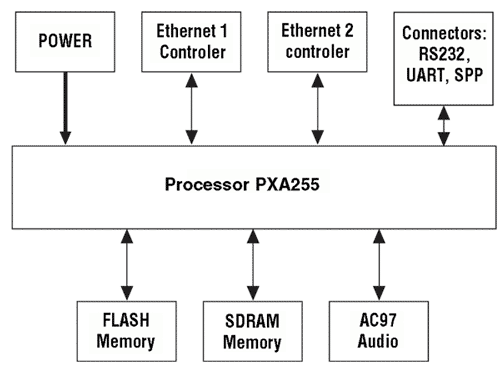SLD PXA PCBoard
The PXA255 module board is intended for running embedded network applications. The PXA255 board is optimised for the development of highly efficient Internet devices, and for network infrastructure applications.It contains two network interfaces, one for the network connection and the other one for connecting PC. There is audio interface inbuilt, which was necessary for IP phone.
For more challenging tasks where more powerful CPU and larger memory storage is 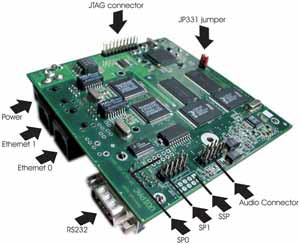 required customer can use PRO version of the board. The board can be also used as network component like a firewall or router/switch etc. In such cases the board is delivered without audio interface which results into purchase price reduction.
required customer can use PRO version of the board. The board can be also used as network component like a firewall or router/switch etc. In such cases the board is delivered without audio interface which results into purchase price reduction.
The PXA255 board is based on the new Intel XScale architecture. Intel XScale processor family increases efficiency and decreases processor power consumption. The Intel XScale micro architecture is based on the Intel Strong ARM technology. The PXA255 board includes Intel XScale processor, SDRAM and Intel StrataFlash memory, 2 Ethernet controllers,3 serial interfaces and 1 stereo audio output.
Hardware Specifications
- CPU Intel XScale PXA255
- 200/400 MHz frequency
- 8..32 MB FLASH-erase-protection switch memory
- 32..64 MB SDRAM
- 2 x 10Mb Ethernet
- Audio Codec AC97
- Power: 7,5V (connector: 5.5x2.1mm, center positive ), power consumption up to 5W
- Dimension: 100 x 107 x 24 mm
Interfaces
- 4x RS-232
- 2x 10BASE-T Ethernet (cs89x0)
- 1x JTAG connector
Software specifications
- OS Linux version 2.4.19-rmk4-pxa2
- File systems (ROMFS, JFFS2, EXT2, NFS, RAMFS)
- Terminal
- SSH, TFTP
- LINUX basic utilities (Bash, Vi, ...)
- Network drivers
- Demo MP3 player
Linux operating system is pre-installed on the board as default. The firmware and customer made applications can be changed via JTAG interface, development boot loader or through mtd device (on the running kernel). Board is manageable through standard RS-232 serial link. For the effective work user should use usual terminal station. Later when network interfaces are configured user can manage whole system remotely via LAN/internet using SSH protocol. Also remote software upload/upgrade is supported by system. In FLASH memory can be stored customer made applications. The board can be delivered also without preinstalled operating systems.
PXA255 serial ports
The PXA250 has three asynchronous serial ports (FFUART,BTUART and STUART) and one synchronous serial port (SSPC).
- The FFUART supports full handshaking, while the BTUART supports RTS/CTS only.
- Only two UARTs of the processor are routed to the connectors: FFUART and STUART.
- The FFUART is shared by the SP0 (10-pin heder) and RS-232 Connectors (DB-9 male) at V.28 power levels.
- The SP1 connector(10-pin header) connects to the BTUART and adopts for power levels of 3.3-5V.
The synchronous serial port (SSP) supports three protocols: National Semiconductor's Microwire, Texas Instruments Synchronous Serial Protocol, and Motorola’s Serial Peripheral Interface. This port is routed to a 10-Pin Header SSP.
SLD PXA255 medule in a DIMM format
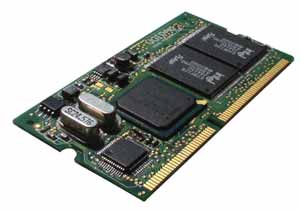 The SLD PXA255 module in a DIMM format is smaller than a credit card and ready to be designed into your embedded system. The module occupies an area of just 67 x 36 mm.
The SLD PXA255 module in a DIMM format is smaller than a credit card and ready to be designed into your embedded system. The module occupies an area of just 67 x 36 mm.
The PXA255 module includes a Intel®XScale™ processor, SDRAM and Flash memory. The integrated LCD-controller enables direct connection of a LCD screen.
The module is shipped with a bootloader (Armboot) and Linux operating system that is equipped with drivers for peripherals found on the module. The module is designated for customers who use the PXA 255 processor as the core of their applications.
Its use has the following benefits:
- easy replacement of processor and memory
- lower technological demand on development of one's own hardware (technologically complex and critical parts may be found on DIMM Module)

Block diagram of SLD PXA255 in a DIMM format
DIMM BASE BOARD
Intel PXA255 DIMM PC board is intended for running embedded network applications.DIMM PC is designed mainly for the development of highly efficient Internet devices, and for network infrastructure applications.
DIMM PC is delivered in variety configurations, which may differ in processor frequency, SDRAM or FLASH size and amount of peripheries. CPU, SDRAM and FLASH memory is located on stand alone DIMM module, that means is easy to change processor frequency or memory size, without necessity to change main DIMM base board. If you need next extend FLASH storage space, plug Compact FLASH card in base board.
The interfaces of DIMM BASE BOARD
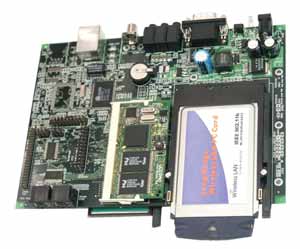 2 x 100Mb Ethernet
2 x 100Mb Ethernet
- 2 x PCMCIA slot, 1 x Compact Flash,
- 1 x IDE connector – in real time can work:
- 2 x PCMCIA
- 1 x PCMCIA + 1 x Compact Flash
- 1 x PCMCIA + IDE
- 1 x Compact Flash + IDE
- RS-232 connector (terminal output)
- IR serial interface
- SPI interface
- UART serial connector (3.3-5V)
- JTAG connector
- Ac´97 audio (stereo LINE IN/OUT, MIC IN)
- Standard display interface with Touch screen
- ATA2 interface for connecting HDD, CDROM…
- 2 x PS/2 – mouse and keyboard - controlled
by programable IO coprocessor - Real Time Clock battery backup
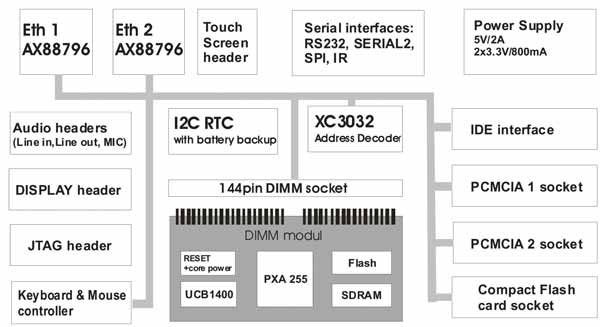
Block diagram of DIMM BASE BOARD
There are two ASIX 100Mbit fast Ethernet chip AX88796. Each chip is equipped with three status LED’s (active status, speed status, link status)
The card contains two 3,3V PCMCIA slots and one 3,3V Compact FLASH connector. Two of them can be used at the same time. The board can be either powered by AC adapter or Power LAN system via power cord (outdoor application). A standard 2.1mm DC jack is used to provide power the board. The center of jack is positiv. It is recommended to power the board by stabilised source 7.5V-12V.
Author: Oldrich Mrazek
Translated by: Zbynek Soban
Download & links
- Other Information about SLD devices, starter kits, etc. http://www.HW-group.com/products/sld/
- Intel PXA255 DIMM PC board - a detailed datasheet dimm_pc.pdf
- Primary source about ARM architekture: www.arm.com.
- Arm Reference Manual: www.arm.com/ARM.
- Information about PXA250 firmware and hardware you can find on: developer.intel.com
- Sources and manuals for gcc, gdb, glib+ and binary utilities : www.gnu.org.
- Kernel souces and patches are on the page: www.arm.linux.org.uk.
- Information about PXA250 firmware and hardware: developer.voipac.com
Related articles
- RS 485 & RS 422 - http://www.hw-server.com/docs/rs485.html
- RD2 Kit - HW Description - http://www.hw-server.com/constrc/rd2kit.html
- RD2 Kit - HW Description - http://www.hw-server.com/programming/rd2kit.html
- RD2 Kit - HW Description - http://www.hw-server.com/hw_products/rd2kit.html
- Atmel AT89C2051 programmer - http://www.hw-server.com/constrc/aatp.html

